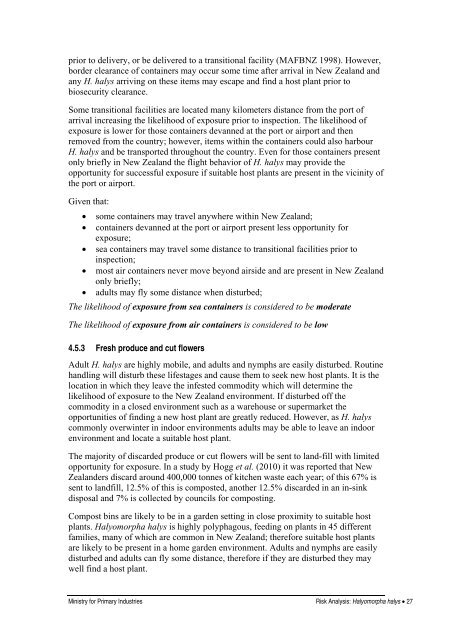Risk analysis of Halyomorpha halys - Biosecurity New Zealand
Risk analysis of Halyomorpha halys - Biosecurity New Zealand
Risk analysis of Halyomorpha halys - Biosecurity New Zealand
You also want an ePaper? Increase the reach of your titles
YUMPU automatically turns print PDFs into web optimized ePapers that Google loves.
prior to delivery, or be delivered to a transitional facility (MAFBNZ 1998). However,<br />
border clearance <strong>of</strong> containers may occur some time after arrival in <strong>New</strong> <strong>Zealand</strong> and<br />
any H. <strong>halys</strong> arriving on these items may escape and find a host plant prior to<br />
biosecurity clearance.<br />
Some transitional facilities are located many kilometers distance from the port <strong>of</strong><br />
arrival increasing the likelihood <strong>of</strong> exposure prior to inspection. The likelihood <strong>of</strong><br />
exposure is lower for those containers devanned at the port or airport and then<br />
removed from the country; however, items within the containers could also harbour<br />
H. <strong>halys</strong> and be transported throughout the country. Even for those containers present<br />
only briefly in <strong>New</strong> <strong>Zealand</strong> the flight behavior <strong>of</strong> H. <strong>halys</strong> may provide the<br />
opportunity for successful exposure if suitable host plants are present in the vicinity <strong>of</strong><br />
the port or airport.<br />
Given that:<br />
some containers may travel anywhere within <strong>New</strong> <strong>Zealand</strong>;<br />
containers devanned at the port or airport present less opportunity for<br />
exposure;<br />
sea containers may travel some distance to transitional facilities prior to<br />
inspection;<br />
most air containers never move beyond airside and are present in <strong>New</strong> <strong>Zealand</strong><br />
only briefly;<br />
adults may fly some distance when disturbed;<br />
The likelihood <strong>of</strong> exposure from sea containers is considered to be moderate<br />
The likelihood <strong>of</strong> exposure from air containers is considered to be low<br />
4.5.3 Fresh produce and cut flowers<br />
Adult H. <strong>halys</strong> are highly mobile, and adults and nymphs are easily disturbed. Routine<br />
handling will disturb these lifestages and cause them to seek new host plants. It is the<br />
location in which they leave the infested commodity which will determine the<br />
likelihood <strong>of</strong> exposure to the <strong>New</strong> <strong>Zealand</strong> environment. If disturbed <strong>of</strong>f the<br />
commodity in a closed environment such as a warehouse or supermarket the<br />
opportunities <strong>of</strong> finding a new host plant are greatly reduced. However, as H. <strong>halys</strong><br />
commonly overwinter in indoor environments adults may be able to leave an indoor<br />
environment and locate a suitable host plant.<br />
The majority <strong>of</strong> discarded produce or cut flowers will be sent to land-fill with limited<br />
opportunity for exposure. In a study by Hogg et al. (2010) it was reported that <strong>New</strong><br />
<strong>Zealand</strong>ers discard around 400,000 tonnes <strong>of</strong> kitchen waste each year; <strong>of</strong> this 67% is<br />
sent to landfill, 12.5% <strong>of</strong> this is composted, another 12.5% discarded in an in-sink<br />
disposal and 7% is collected by councils for composting.<br />
Compost bins are likely to be in a garden setting in close proximity to suitable host<br />
plants. <strong>Halyomorpha</strong> <strong>halys</strong> is highly polyphagous, feeding on plants in 45 different<br />
families, many <strong>of</strong> which are common in <strong>New</strong> <strong>Zealand</strong>; therefore suitable host plants<br />
are likely to be present in a home garden environment. Adults and nymphs are easily<br />
disturbed and adults can fly some distance, therefore if they are disturbed they may<br />
well find a host plant.<br />
Ministry for Primary Industries <strong>Risk</strong> Analysis: <strong>Halyomorpha</strong> <strong>halys</strong> 27
















